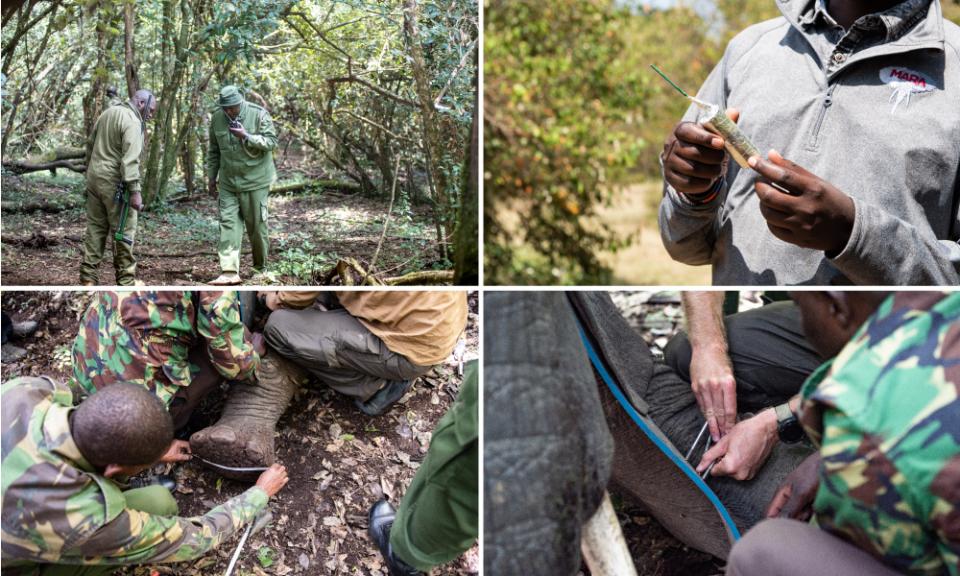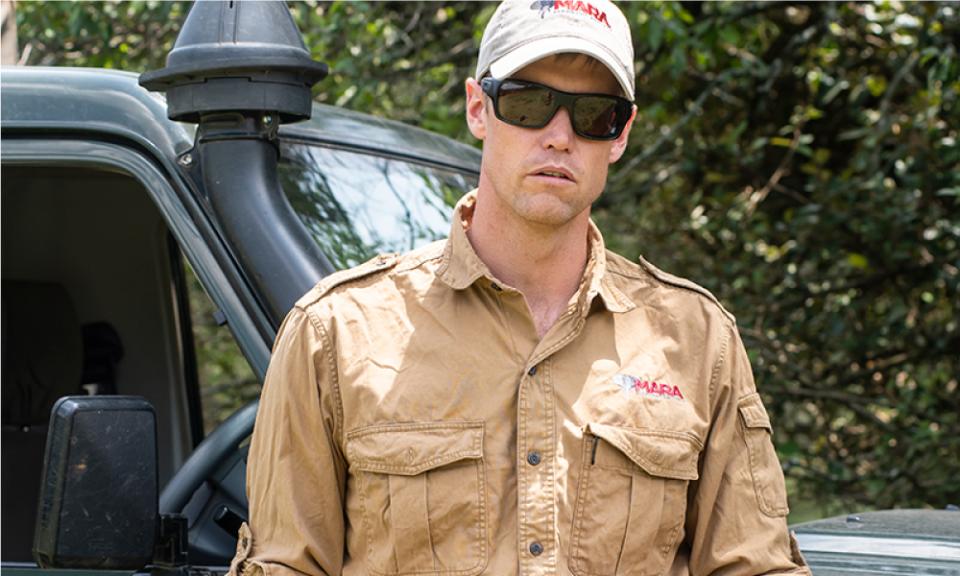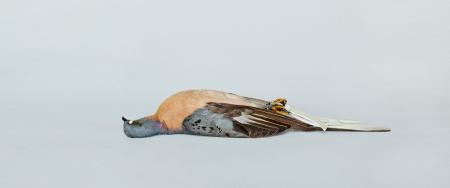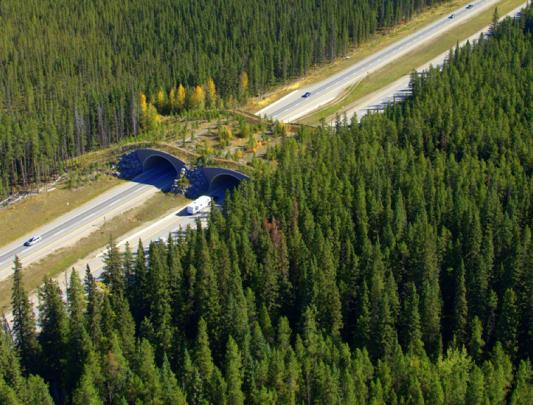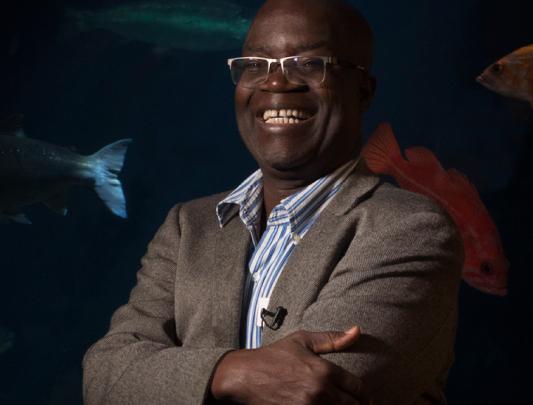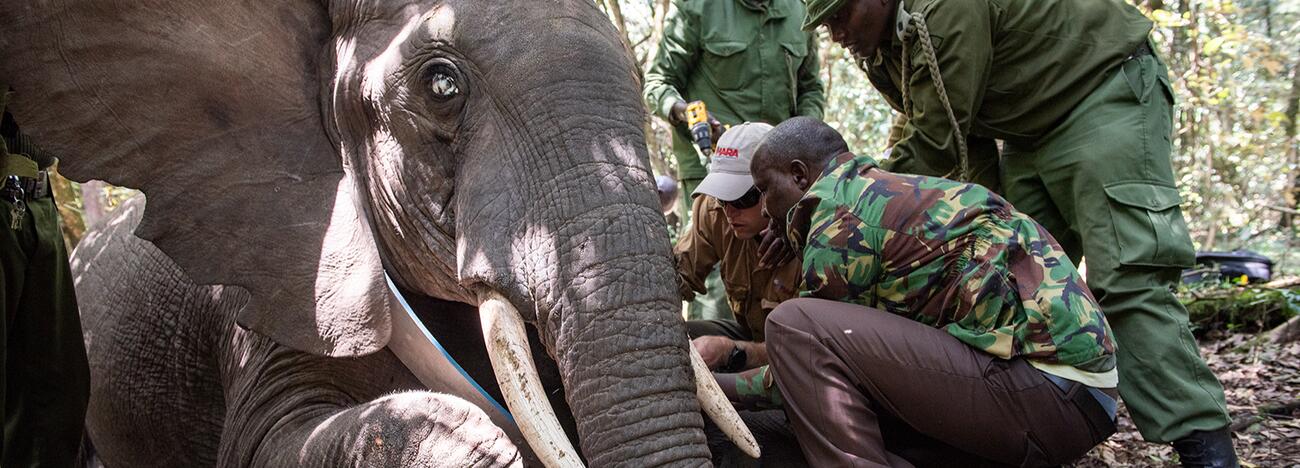
Can satellite technology save the African elephant?
Elephants are key to Kenya’s ecology, culture and economy, yet conflict with humans is threatening their survival. Can satellite technology provide a lifeline?
Twigs and other vegetation snap and crackle underfoot as a group of men tread warily through the dense and lush Nyakweri Forest in southern Kenya’s Maasai Mara, tracking elephants.
Despite their vast bulk, the pachyderms are difficult to find, their wrinkled grey hides blending chameleon‑like into the variegated woodland, soft round feet moving almost soundlessly on the damp forest floor. Such stealth also makes them dangerous, and the group – consisting of conservation rangers, an armed wildlife officer, a veterinarian and UBC alumnus Jake Wall, PhD’15 – are extra cautious, especially since their target is a herd of bull elephants, creatures unafraid of asserting their claim to this verdant jungle.
The group follows elephant spoor – a broken branch here, a footprint there, the occasional pile of fresh dung – and receive advice via walkie talkie from Marc Goss, CEO and helicopter pilot for Kenya’s Mara Elephant Project (MEP), who is flying high above the Nyakweri canopy, helping track the herd.
Other than the sporadic radio crackle, there is silence. They must come close enough to the herd to tranquilize one individual and attach a tracking collar. The armed Kenya Wildlife Service officer stays at the front of the group, in case an elephant charges. The team knows the drill: “get behind the gun; don’t run; stand your ground.”
An elephant is tranquilized and collared. Video by Roberta Staley.
Suddenly, the loud cracks of splintering branches – elephants feeding – indicate the herd is close. Veterinarian Campaign Limo, accompanied by Wall, who became director of Research and Conservation for MEP earlier this year, move towards them. It is imperative the animals aren’t spooked, so Limo creeps further forward by himself, dart gun at the ready, the syringe barrel full of tranquilizer M99, or etorphine, which will render an elephant paralyzed but still conscious. Limo must get to within 40 to 50 metres of his target animal – about two‑thirds the length of a hockey arena – for a precise hit into muscle. If he hits bone or tendon, the M99 will not be absorbed and the team’s tracking efforts will have been in vain.
A detonation of startled crashing indicates that Limo has hit his target. Now, the team must find the animal in the thick underbrush, all the while moving as silently as possible to avoid alerting a nearby herd of feeding Cape buffalo – huge, burly, aggressive creatures that attack with the slightest provocation.
The spoor trail is faint, and the ranger team communicates with the helicopter for help. Five minutes later, as copper‑tailed monkeys hoot warnings and black and white butterflies dance in frenetic circles about their heads, the team finds the empty syringe, with its bright pink feathered tail piece. M99 takes effect in 10 minutes, so the elephant must be close to collapse. One keen‑eyed tracker detects a trail, and 15 minutes later, the team spies a grey‑brown mass off in the distance. A young bull elephant is down, but lying on his sternum, limbs splayed out, left leg tucked underneath his body. With his weight bearing down on lungs and heart, the team must work fast to get the tracking collar on and administer the antidote – epinephrine – in order to minimize stress. Kneeling down beside the elephant’s huge head, Wall drops his blue bag, which contains tools for cutting the heavy Kevlar band to size and bolts to secure it.
Powered by six D‑cell lithium batteries, the high‑tech collar contains GPS software, an inexpensive VHF beacon and an expensive Iridium satellite transmitter with data storage capability that transmits data to a software tracking system Wall co‑developed called EarthRanger. Linked to the Iridium satellite system, a constellation of 66 active satellites orbiting the planet, EarthRanger gives conservationists 24‑hour, real‑time access to their collared research subjects, and features an alert system that allows them to intercede in instances of poaching or conflict with villagers trying to protect their crops. It has become a key tool for Protected Area Management initiatives throughout Africa.
Rangers help Wall pull the heavy collar over the elephant’s neck and tighten the bolt using a socket wrench. Since the pachyderm is young, about 20 years of age, the collar must be left loose enough to accommodate future growth as well as the breeding period, called musth, when male elephants’ neck muscles swell. It is not ideal, as the collar might slip off. Other frustrating fails may include malfunctioning batteries.
But collaring is the elephant’s best hope in terms of the survival of his species. According to the Washington office of the World Wildlife Fund, as many as 10 million elephants roamed the African continent in 1930. Decimated by poaching, habitat loss, sport hunting and conflict with human populations, they now number just 415,000. Elephants are deemed “vulnerable” by the International Union for Conservation of Nature, which means they will become endangered unless circumstances threatening their survival improve. Keeping track of their movements not only helps protect them from poachers and human‑elephant conflict, but supplies data to determine the size and location of ranges they need to thrive.
As many as 10 million elephants roamed the African continent in 1930. Decimated by poaching, habitat loss, sport hunting and conflict with human populations, they now number just 415,000.
While Wall continues the collaring, the vet checks the heart rate and looks for wounds to treat. The elephant’s foot and tusks are measured, and a portion of tail hair is taken for carbon isotope analysis. By determining the C3 and C4 ratios, which are associated with different plants in the diet, scientists can determine where the elephant is feeding and whether it might be raiding farmers’ crops – a key factor in human‑elephant conflict.
Through all of this the elephant half‑sits, fully alert yet incapable of doing anything beyond a slow, meditative flap of his ears, his trunk flaccid in front of him. He manages a deep‑chested, drawn‑out rumble, suggestive of deep disgruntlement. Despite the surreal experience, most elephants “will get up and start eating” afterwards, Wall remarks when the pachyderm is safely on his feet, blowing a deep, sonorous call to his herd, then vanishing like a shadow back into the forest.
Back at MEP’s headquarters, doors and windows are flung open to the breeze to help keep the interior cool. (A male lion has been hanging out in the bush about 50 metres away, deterring casual strolls.) Wall peers up at an enormous, 65” Sony television screen mounted adjacent to his computer. It displays tiny elephant icons against a green and brown background that indicates geographical variance, such as forest and open grassland.
“That’s him,” Wall says with satisfaction, pointing to one of the icons, which is labelled “Fitz.” It’s the newly collared young bull, named in honour of the owner of Angama Mara safari camp, which paid the $26,000 cost of collaring the animal, a fee covering the hardware, helicopter time, drugs, and ongoing digital and field monitoring. Fitz is one of 21 MEP‑collared pachyderms that Wall and the ranger team track and monitor on an annual budget of just $900,000, made up entirely of donations. “It’s a struggle to raise enough money to keep protecting elephants,” Wall says.
And yet, as a keystone species, the African elephant is invaluable for myriad reasons, not least of which is the eco‑tourism dollars each animal brings into a country, an estimated $1.6 million over its lifetime – in comparison to $21,000 for its raw ivory, according to the Sheldrick Wildlife Trust, a 42‑year‑old Kenya‑based organization that operates an orphan elephant rescue and rehabilitation program.
Despite the success of today’s collaring, Wall is slightly disappointed. With only metre‑long tusks, Fitz isn’t a likely target for poachers, and countering poaching is one of the motivations for collaring. From 2010 to 2012 alone, 100,000 elephants in Africa were killed for their ivory. While poaching has declined, thanks to harsher penalties and the vigilance of organizations like MEP – which also runs intelligence operations to disrupt poachers’ clandestine killing operations, confiscate their smuggled ivory and arrest them – the slaying of elephants remains a constant threat, due to the high demand for ivory in Asia.
The icons on the screen leave digital colour trails, allowing precise monitoring of an elephant’s location and direction of travel, as well as its speed. If a digital trail turns into a longer streak, it indicates that a normally placid elephant is running. This is a warning that an elephant may be fleeing for its life, possibly from poachers or armed villagers.
But Fitz’s collar will still be useful. The youngster is integrated into a bachelor herd of bulls; following his movements will allow monitoring of his older buddies by proxy, including those whose larger ivories make them attractive to poachers.
The icons on the screen leave digital colour trails, allowing precise monitoring of an elephant’s location and direction of travel, as well as its speed. If a digital trail turns into a longer streak, it indicates that a normally placid elephant is running. This is a warning that an elephant may be fleeing for its life, possibly from poachers or armed villagers.
The system also indicates when an elephant breaches a virtual “geo‑fence” by moving into farming areas. At this time of year, maize crops are ripening. The sweetcorn is loved by pachyderms for its high caloric content and taste. However, villagers depend on it for food and income and have no qualms about protecting their precious harvest with spears and arrows.
These are emergency situations calling for immediate action – day or night – from MEP’s teams of rangers, who are connected to EarthRanger’s short message service (SMS) and stationed in temporary camps across the 11,500‑square kilometre range MEP monitors.
Each ranger team consists of four to eight men, mostly local Maasai who have undergone rigorous training in weapons handling, conflict resolution, advanced first aid and elephant wrangling, which is when the animals are driven out of crop fields with chili bombs and firecrackers, among other benign deterrents.
The rangers receive a text message or email informing them of changes in the behaviour of a collared elephant that could indicate crop raiding, poaching, or, if an animal is immobile for a five‑hour stretch, severe injury or death. In the case of injury caused by humans, such as snaring, or wounds from arrows, spears or guns, MEP’s mandate is to dispatch a helicopter and veterinarian to anaesthetize the animal and treat it. “It’s incredible what elephants can heal from,” says Wall.
It is largely the result of Wall’s inventiveness that MEP has become a leader in Africa for hi‑tech wildlife management. He began developing EarthRanger while undertaking his PhD with UBC’s geography department, focusing on geospatial studies of elephants. During this time, he worked with Kenya‑based Save the Elephants, writing the code and designing the database that the organization used to track 300 pachyderms across the continent. Wall was profoundly influenced by a now‑retired zoology professor, Tony Sinclair (“Mr. Serengeti”). “He was a true ecologist,” says Wall. “He did unbelievable research in the Serengeti on migration and was a legend at UBC.”
Wall figured out how to upload data in real time onto Google Earth while creating a backend supported by a geographic information system (GIS) provided by California‑based Environmental Systems Research Institute. He went on to create a toolkit for movement‑ecology analysis, using GPS tracking data and cloud‑based computing to calculate elephant range across Africa.
Jake Wall is director of Research and Conservation for Kenya’s Mara Elephant Project.
Such data is invaluable for conservation initiatives and the development of public policy at the national level, informing African governments about crucial migration corridors that preserve connectivity between the vast feeding ranges needed by elephants, who travel anywhere from five to 65 kilometres a day in their search for food and water.
As Wall was finishing his PhD, he was approached by Vulcan Inc. in Seattle, the data company started by the late Microsoft co‑founder and philanthropist Paul Allen. Vulcan was interested in elephants and the application of technology in conservation. Wall had reached his technological limits and was worried about security and the possibility of poachers hacking into his system. Acting as a consultant for Vulcan, Wall worked with their developers to build EarthRanger, recently achieving the goal of creating interface capabilities that have enabled the integration of data from various feeds: collared elephants, MEP’s ranger vehicles and helicopter, as well as individual trackers.
The data collected is nuanced, highly detailed and analyzable, providing a rich store of information to facilitate further study by PhD students and post‑docs. “We’re hoping that that data collection will help inform our conservation practices,” says Wall. As an example, he points to the possibility of having farmers switch maize for sunflowers or essential oils like lavender – crops shunned by elephants. However, such agricultural changes must be made in collaboration with local communities, and switching will require more comprehensive study, such as ensuring that there are consistent markets for new crops, Wall says. Conveniently, MEP will soon accommodate additional researchers at its headquarters, thanks to construction of a new research camp with living quarters and a self‑serve mess hall.
As they journey across the savannah, elephants transport seeds in their dung, contributing to plant biodiversity and recycling nutrients. By eating bushes, pushing over small trees and digging up soil, they help open up forests for the expansion of grasslands.
Wall maintains a level‑headed objectivity when it comes to his research. But he is obviously driven not only by his love for elephants, but for Africa itself. Wall’s mother worked with the Canadian International Development Agency until 2013; his father was a career diplomat with Global Affairs Canada. As a result, Wall attended high school in Kenya and fondly recalls long hikes through the African bush.
Elephants are valuable not just as a tourist draw but for the crucial role they play as environmental architects and gardeners, says Wall. As they journey across the savannah, elephants transport seeds in their dung, contributing to plant biodiversity and recycling nutrients. By eating bushes, pushing over small trees and digging up soil, they help open up forests for the expansion of grasslands, benefitting a multitude of ungulates such as zebras, wildebeest, gazelles, antelopes and giraffes populating the savannah. But habitat loss has contracted elephant ranges and reduced their sources of food, forcing them closer to human habitation.
Despite the cutting‑edge science he is developing and the data he is collecting, Wall is distressed by the feeling that it may not be enough. “I feel a sense of responsibility towards elephants. But it’s more than that; it’s the environment. These environmental systems are collapsing before our eyes. So it’s a sense of panic; sometimes I lie awake at night – stressed about what we’re doing to the planet.” Despite such a disheartening reality, Wall is unwavering in his work, never taking his eye of his ultimate goal. “We want to move from conflict to co‑existence, where wildlife and humans can live sustainably for the long term.”
Header photo courtesy of Tallulah Photography.
























